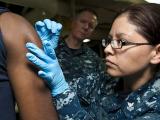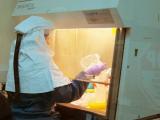Aug 9, 2012 (CIDRAP News) – Mail carriers reached about 95% of targeted Twin Cities addresses in a recent test of a plan to deliver antibiotics to people's homes in response to a bioterrorism attack, and some confusion about lines of authority was the main glitch, according to the Minnesota Department of Health (MDH).
This week the MDH released a summary of its after-action review of the exercise, which was conducted in Minneapolis, St. Paul, and some suburbs on May 6. In the test, mail carriers delivered empty pill bottles and explanatory fliers to about 33,000 homes in four zip codes.
The event, which stems from a federal government initiative to prepare for the threat of bioterrorism, was billed as the first full-scale exercise of the idea of using the US Postal Service (USPS) to provide antibiotics as part of the response to an attack. Officials say the postal approach would be used to supplement mass-dispensing sites, which would be the main tool for supplying medical countermeasures to protect the population from anthrax or other pathogens.
Thirty-six delivery teams, each consisting of a mail carrier and a law enforcement officer, participated in the exercise, according to Jane Braun, MPH, director of emergency preparedness for the MDH.
The teams delivered the bottles and fliers to 32,998 of the 34,672 addresses in the USPS route guides for the targeted zip codes, plus 78 other addresses identified during the exercise, according to the report.
For the 1,674 addresses where no deliveries were made, the reasons included vacant residences, dangerous dogs, flooding from heavy rains the day of the exercise, mailboxes that were locked or too small for the bottle, and expiration of the time allotted for deliveries in some of the zip codes.
Regarding the last point, Braun explained that because of limited funding, there was a 12-hour time limit for Hennepin County law officers who participated. "Some of the routes were very large, and we were running up to the end of the time we had allocated," she said. "In a real situation we'd have as many shifts as we needed."
Braun said each delivery team covered from two to three normal mail routes and worked from 8 to 12 hours. The exercise targeted two St. Paul zip codes, one on Minneapolis's North side, and one that covers parts of Minneapolis, Robbinsdale, Golden Valley, and Crystal.
The exercise involved 23 local, state, and federal government agencies and one community organization, according to the report. Four different "command entities"—two within the USPS and two in law enforcement—had responsibility for the delivery teams, and that led to some confusion when it came time to reassign or demobilize teams after completion of their assigned routes, the report says.
"Lack of a defined process for reallocating teams after they had completed their assigned routes delayed reallocation of teams to new routes by as much as 40 minutes," the report says.
"It was really the first time we ever had this many agencies working together on an exercise like this. Inevitably in an exercise that big there's a little confusion on who has the final say on what," said Braun.
She also said there was a little confusion over the terminology the delivery teams used in reporting completion of their routes. Since each team had the equivalent of two to three normal mail routes, when they said they were 50% done, for example, it wasn't always clear if they meant 50% of the first route or 50% of the whole assignment, she explained.
Public communication efforts before and during the exercise were graded as successful, according to the report. Media representatives in the involved agencies used a wide range of channels to provide information about the event, from news releases to social-media messages.
Braun said an information hotline received only three calls during the exercise itself, and agencies received a few more calls in the ensuing days.
The report lists the following as other successes in the exercise:
- MDH and USPS officials "successfully coordinated the notification, activation, and assembly of the personnel and equipment" needed to deliver the pill bottles.
- Law officers assembled as planned and performed their assigned roles.
- Participants coped effectively with "real world" problems like flat tires and traffic congestion.
Braun said the participating agencies are still working on their full after-action report and improvement plan. Lessons gleaned from the exercise will be shared with other cities that are working on similar plans, such as Boston, Philadelphia, and Seattle, which have run more limited tests of the concept, according to the report.
No further exercises are planned for now, Braun said. "We're now waiting for further direction from the federal government on how they want to develop this," she said.
The US Department of Health and Human Services provided $200,000 for the exercise, while the MDH provided in-kind contributions through some of the staff time devoted to it, she said.
See also:
May 7 CIDRAP News story "Twin Cities medicine-by-mail test called successful"


















